|
Mercedes SLR McLaren
Debut: 2003
Maker: Mercedes-Benz
Predecessor: no |
|
 When
Mercedes-Benz showed the Vision SLR concept car in 1999, it just wanted
to build a Ferrari 550 Maranello-beater. That meant a user-friendly
production
car at a price around £150,000. To realize it, Mercedes decided
to
hand over the project to McLaren and its engineering ace Gordon Murray,
the father of McLaren F1. Under the leadership of Gordon Murray, the
SLR
evolved into an even hotter machine. It is still a front-engined GT,
but
performance elevated to the level of Ferrari Enzo, Porsche Carrera GT,
Pagani Zonda and the like. Unfortunately, price is also doubled to
£313,000,
thus production volume is scaled back to 500 cars a year. According to
the latest plan, McLaren will build SLR for a 7-year life span in a new
facility beside its headquarters at Woking, UK. That means a total of
3500
cars will be produced, still far more than its rivals. When
Mercedes-Benz showed the Vision SLR concept car in 1999, it just wanted
to build a Ferrari 550 Maranello-beater. That meant a user-friendly
production
car at a price around £150,000. To realize it, Mercedes decided
to
hand over the project to McLaren and its engineering ace Gordon Murray,
the father of McLaren F1. Under the leadership of Gordon Murray, the
SLR
evolved into an even hotter machine. It is still a front-engined GT,
but
performance elevated to the level of Ferrari Enzo, Porsche Carrera GT,
Pagani Zonda and the like. Unfortunately, price is also doubled to
£313,000,
thus production volume is scaled back to 500 cars a year. According to
the latest plan, McLaren will build SLR for a 7-year life span in a new
facility beside its headquarters at Woking, UK. That means a total of
3500
cars will be produced, still far more than its rivals.
The
development of SLR was never smooth, because the requirements of
Stuttgart
conflicted with the vision of Gordon Murray from time to time - the
former
wanted more luxury and quality, the latter wanted lightness and
pureness.
Of course, the client always wins, and the kerb weight of SLR increased
from the original target of 1400kg to the production car’s 1693kg.
And
this is already a car employing all-carbon fiber body and monocoque
chassis
! in the press release, Mercedes used thousands of words to describe
the
advanced construction of the chassis, such as the world’s first carbon
fiber crash structure, new production method and blah blah blah. Excuse
me, if I build a supercar weighing 300kg more than rivals and only
187kg
lighter than a standard SL55 AMG (which has retractable roof,
remember),
I will be shamed to mention the word "carbon-fiber". No wonder Gordon
Murray
did not appear in the introduction of SLR. This is definitely not his
best
car.
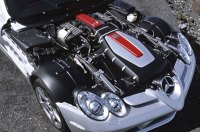 Anyway,
the concept of SLR is inspiring. Gordon Murray shares Ferrari’s opinion
that a good handling FR car must have a slight rear-biased weight
distribution
to sharpen steering and improve traction. Therefore he put the engine
far
back in the chassis, not just behind the front axle, but the whole
engine
is behind the front wheels. If you don’t believe, open the bonnet and
you
will see the front half of the engine compartment contains just the
suspensions
and a big air filter. The compact AMG 5.5-litre supercharged V8
occupies
the rear half. Murray could choose a bigger twin-turbo V12 from AMG,
but
he needs the compact size of the V8 to achieve the desired balance.
Besides,
it weighs just 232kg, far lighter than the twin-turbo V12 and just 7kg
heavier than Ferrari Enzo’s naturally-aspirated V12. The SLR can
therefore
achieve 49:51 weight distribution front-to-rear. Anyway,
the concept of SLR is inspiring. Gordon Murray shares Ferrari’s opinion
that a good handling FR car must have a slight rear-biased weight
distribution
to sharpen steering and improve traction. Therefore he put the engine
far
back in the chassis, not just behind the front axle, but the whole
engine
is behind the front wheels. If you don’t believe, open the bonnet and
you
will see the front half of the engine compartment contains just the
suspensions
and a big air filter. The compact AMG 5.5-litre supercharged V8
occupies
the rear half. Murray could choose a bigger twin-turbo V12 from AMG,
but
he needs the compact size of the V8 to achieve the desired balance.
Besides,
it weighs just 232kg, far lighter than the twin-turbo V12 and just 7kg
heavier than Ferrari Enzo’s naturally-aspirated V12. The SLR can
therefore
achieve 49:51 weight distribution front-to-rear.
From
outside, you can also see its attention to balance. The car has a very
long engine compartment while the small passenger compartment sits just
in front of the rear wheels. The basic design follows that of the
Vision
SLR, but the profile is evolved to wedge shape to reduce aerodynamic
lift
at the rear. However, the stunning F1 nose is retained to remind you it
is a McLaren-Mercedes.
 Does
it look handsome? it might not be as beautiful as Murcielago and Zonda,
but it is undoubtedly a good looking GT. Prettier than Enzo, more
striking
than Carrera GT. Does
it look handsome? it might not be as beautiful as Murcielago and Zonda,
but it is undoubtedly a good looking GT. Prettier than Enzo, more
striking
than Carrera GT.
To
allow the SLR to run stable at 200mph, Gordon Murray sacrificed drag
for
downforce and cooling. As a result, drag coefficient has been increased
from the concept car’s 0.29 to the production car’s 0.374. To allow the
adoption of flat underbody and diffusers, Murray had to ask AMG to
develop
a side exhaust system. Catalytic converters and mufflers locate at east
and west of the V8 and exhaust gas flows out directly at the exhaust
pipes
behind front wheels. Shark-like side air vents are opened to help
cooling
the cats and mufflers.
The
engine is modified from SL55AMG’s. Firstly, the engine is converted to
dry-sump to lower its center of gravity as well as to ensure effective
lubrication under high cornering force. Secondly, a slightly
faster-rotating
IHI Lysholm-type supercharger lifts boost pressure from 0.8 to 0.9 bar.
Then there are other enhancement to intake, exhaust and cooling, lower
friction and lighter moving parts etc. The result is 626 horsepower at
6500rpm - amusingly, just 1 horsepower short of McLaren’s last car.
This
put it above Porsche Carrera GT (612hp) and Zonda (555hp), although
still
some way behind Enzo (660hp).
 By
the standard of supercharged engines, this one is very efficient
indeed.
It pumps out 115 horsepower per litre, compare with Ford GT’s 93hp /
litre.
It also loves to rev. Despite of the 3-valve head and lack of variable
valve timing, redline is set at 7000rpm, compare with Ford GT’s
6500rpm.
Of course, it shares the common strength of all supercharged engines:
torquey.
From 3250 rpm all the way to 5000rpm, it delivers 575 lbft of torque,
beating
all its rivals. At just 1500rpm, it already generates more torque than
Porsche Carrera GT can manage at any rev ! By
the standard of supercharged engines, this one is very efficient
indeed.
It pumps out 115 horsepower per litre, compare with Ford GT’s 93hp /
litre.
It also loves to rev. Despite of the 3-valve head and lack of variable
valve timing, redline is set at 7000rpm, compare with Ford GT’s
6500rpm.
Of course, it shares the common strength of all supercharged engines:
torquey.
From 3250 rpm all the way to 5000rpm, it delivers 575 lbft of torque,
beating
all its rivals. At just 1500rpm, it already generates more torque than
Porsche Carrera GT can manage at any rev !
No
wonder a 5-speed automatic transmission is deemed to be sufficient.
From
the beginning, Mercedes insisted the car must use automatic gearbox to
deliver an ease of control unfound in other supercars. There were hopes
that its new 7G-Tronic 7-speed automatic could be available, but
unfortunately
in the mean time it is not strong enough to cope with the SLR engine,
so
the old 5-speeder is used instead.
To
reduce vibration, the engine and transmission are not bolted directly
to
the carbon-fiber monocoque. Instead, they are mounted on an aluminum
cradle
(which also mounts the front suspensions). The cradle is then bolted to
the monocoque. At the rear, suspensions and rear axle are bolted to the
integral metal link points on the monocoque. All suspensions are by
forged
aluminum double wishbones. Surprisingly, there is no adaptive damping
and
Active Body Control. It just employs conventional springs and dampers.
On
the Road
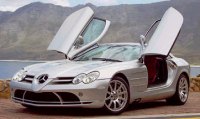 The
SLR has butterfly doors like Ferrari Enzo. Despite of its tremendous
weight,
the cockpit is rather cramped. Headroom and legroom are tight if you
are
over 6ft 2in. Steering wheel is close to driver. Nevertheless, the red
leather-clad cabin looks luxurious and is loaded with equipment cannot
be dreamed in other supercars, such as air conditioning with automatic
climate control, CD changer, Bose sound system, mobile phone, satellite
navigation and telescopic steering wheel. Even the tailor-made,
carbon-fiber-backed
leather seats are adjustable electrically back and forth. The
SLR has butterfly doors like Ferrari Enzo. Despite of its tremendous
weight,
the cockpit is rather cramped. Headroom and legroom are tight if you
are
over 6ft 2in. Steering wheel is close to driver. Nevertheless, the red
leather-clad cabin looks luxurious and is loaded with equipment cannot
be dreamed in other supercars, such as air conditioning with automatic
climate control, CD changer, Bose sound system, mobile phone, satellite
navigation and telescopic steering wheel. Even the tailor-made,
carbon-fiber-backed
leather seats are adjustable electrically back and forth.
Start
the V8, shift the automatic gearbox to "Drive" and drive it slowly, the
deep, rubble-bumble exhaust note sounds great ! throttle response of
the
V8 is instantaneous. Press the throttle, the car immediately surges
ahead.
Thanks to the rich bottom to mid-range torque, acceleration is
astonishing.
According to Mercedes, 0-100kph (62mph) takes 3.8 sec, 0-200kph
(124mph)
takes 10.6 sec, 0-300kph (186mph) takes 28.8 sec and the car tops
207mph.
It’s a match with the fastest ever Porsche and runs very close to the
fastest
ever Ferrari, yet the gearbox is still in the "Drive" position ! like
all
fast Mercedes, the SLR McLaren is easy to drive fast.
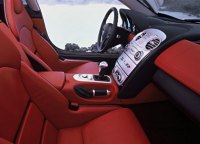 But
it is not the most refined. There is a great deal of tire noise and
suspension
noise transmitted to the cabin, blame to the rear suspensions which are
mounted directly to the carbon-fiber monocoque, and they are just
inches
behind the driver. The ride is also less absorbing than expected. It
deals
worst with primary bumps thus is not very suitable for B-roads. As
speed
rise, the damping improves noticeably, offering a stable ride. Adaptive
damping - as fitted to Enzo - could be an answer, but strangely and
ridiculously,
this 1693kg machine does not have it. But
it is not the most refined. There is a great deal of tire noise and
suspension
noise transmitted to the cabin, blame to the rear suspensions which are
mounted directly to the carbon-fiber monocoque, and they are just
inches
behind the driver. The ride is also less absorbing than expected. It
deals
worst with primary bumps thus is not very suitable for B-roads. As
speed
rise, the damping improves noticeably, offering a stable ride. Adaptive
damping - as fitted to Enzo - could be an answer, but strangely and
ridiculously,
this 1693kg machine does not have it.
The
steering is a similar story. On irregular surfaces the weight and
feedback
is inconsistent and even nervous. This is a bad news if you want to
attack
B-roads. Even on smooth surfaces it is not one of the best steering
systems
on the market, because it feels vague and light at the straight-ahead
position.
The weighting improves once you move towards the extreme, and the
2.2-turn
ratio is quick and direct, but it is never full of feel.
Nevertheless,
the handling of SLR is immensely stable and well mannered. Its wide
tracks,
strong grip and rigid chassis help it to corner rock-steadily. The FR
chassis
balances beautifully. Unlike other mid-engined supercars, its handling
bias towards understeer when it approach limit. Of course, you can push
the tail out easily by using the tremendous torque, but the ESP
stability
control - set to be pretty tolerable in normal condition - will dig in
smoothly.
 Unfortunately,
the brakes do not match the handling. On paper, ceramic discs, 370mm
front
with 8-piston calliper, 360mm rear with 4-piston calliper seems to be a
winning formula. Yes, they are really powerful and fade-free under hard
use, but the pedal is unusually difficult to modulate. All is blame to
the complicated, brake-by-wire, Mercedes Sensotronic Brake Control. SBC
has been used in the SL-class quite well, but in the higher performance
SLR and mates with ceramic brake discs it is simply disastrous. As
there
is no hydraulic linkage between brakes and pedal, as it measures only
the
pedal travel to determine brake force, the pedal feel is always soft
and
the driver cannot feel the exact state of braking. As a result, you can
easily overbrake or underbrake the car. If you want to stop the car
hard,
that’s fine, just press the pedal to the bottom. If you want to slow
down
the car into a corner, you will find it is very difficult to apply the
braking smoothly, blame to the lack of pedal feel and the poor
calibration
of the system. Unfortunately,
the brakes do not match the handling. On paper, ceramic discs, 370mm
front
with 8-piston calliper, 360mm rear with 4-piston calliper seems to be a
winning formula. Yes, they are really powerful and fade-free under hard
use, but the pedal is unusually difficult to modulate. All is blame to
the complicated, brake-by-wire, Mercedes Sensotronic Brake Control. SBC
has been used in the SL-class quite well, but in the higher performance
SLR and mates with ceramic brake discs it is simply disastrous. As
there
is no hydraulic linkage between brakes and pedal, as it measures only
the
pedal travel to determine brake force, the pedal feel is always soft
and
the driver cannot feel the exact state of braking. As a result, you can
easily overbrake or underbrake the car. If you want to stop the car
hard,
that’s fine, just press the pedal to the bottom. If you want to slow
down
the car into a corner, you will find it is very difficult to apply the
braking smoothly, blame to the lack of pedal feel and the poor
calibration
of the system.
I can’t
believe Gordon Murray needed SBC. A conventional hydraulic braking
system
is just fine and save weight, why bother with an unnecessary
technology?
he must thought so. Unfortunately, the German might think otherwise.
They
want to show more technologies to their customers - seems that ABS,
ESP,
DSC and "air brake" are not enough to them.
No
wonder Murray disappeared from the public since the car was launched. I
can understand his frustration. His McLaren F1 was so successful
because
he was given full freedom to design and engineer the car. In contrast,
the German Big Brothers had too much say in the SLR project, even in
the
fields they don’t understand.
Mercedes
SLR McLaren is the most exotic front-engined GT ever produced. Its
performance
matches other supercars. Its handling is sharp and capable. Its
practicality
exceeds everyone else - which supercar offer a well-equipped cabin,
automatic
transmission, a lot of electronic driving aids and a boot big enough
for
2 golf bags? unfortunately, it has some serious flaws in braking and
steering.
Besides, it could do better in ride and NVH suppression to match its
otherwise
comfortable manner. Now let’s see whether Ferrari can move the game on.
|
| The
above report was last updated on 25 Dec
2003. All Rights Reserved. |
SLR 722 Edition
|
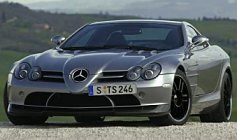 From
the beginning, sales of the SLR supercar has been below the expectation
of Mercedes. This is not helped by the arrival of the excellent Ferrari
599GTB. To stimulate sales, McLaren and Mercedes has introduced an even
faster limited edition called SLR 722. It is so named to link with the
1955 Mille Miglia victory taken by Stirling Moss' 300SLR numbered 722,
so don't confuse it with horsepower number. Only 150 units of the car
will be sold at around £340,000, or £30,000 more than the
standard SLR. All of them have been ordered. From
the beginning, sales of the SLR supercar has been below the expectation
of Mercedes. This is not helped by the arrival of the excellent Ferrari
599GTB. To stimulate sales, McLaren and Mercedes has introduced an even
faster limited edition called SLR 722. It is so named to link with the
1955 Mille Miglia victory taken by Stirling Moss' 300SLR numbered 722,
so don't confuse it with horsepower number. Only 150 units of the car
will be sold at around £340,000, or £30,000 more than the
standard SLR. All of them have been ordered.
In the 722, the AMG supercharged V8 has been reprogrammed to boost
output from 626hp to 650 horsepower, while max torque increases from
575 lbft to 604 lbft. Weight is reduced by 44 kilograms by ditching
sound deadening materials, by using aluminum dampers, lighter alloy
wheels and a lighter fuel tank. The car now tops 209 mph, up 2 mph from
the standard SLR. 0-60 mph is quickened from 3.7 seconds to 3.5
seconds. Perhaps most important to Mercedes, this acceleration edges
out Ferrari 599GTB by 0.1 seconds. From 0-124 mph, the gap expands to
0.7 seconds (10.3 seconds versus 11.0 seconds). That's enough to defend
its title as the world's fastest front-engined grand tourer.
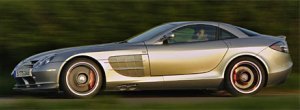 But is
it also the best to drive? unfortunately not. While the Ferrari has a
more delicious V12, a hugely involving handling and truly livable ride
and practicality, the SLR 722 is even more difficult to live with than
the standard SLR. It might have a more aggressive lip spoiler to double
front end downforce, and it has a 10 mm drop in ride height in
combination with stiffer damping, but the result is enhanced straight
line stability rather than improved cornering. Mercedes-McLaren seems
not understand that the car actually needs more compliance to cope with
bumps, not an even harsher ride. On less than smooth surfaces, the
722's handling gets nervous thus it is no where as exploitable as
Ferrari. But is
it also the best to drive? unfortunately not. While the Ferrari has a
more delicious V12, a hugely involving handling and truly livable ride
and practicality, the SLR 722 is even more difficult to live with than
the standard SLR. It might have a more aggressive lip spoiler to double
front end downforce, and it has a 10 mm drop in ride height in
combination with stiffer damping, but the result is enhanced straight
line stability rather than improved cornering. Mercedes-McLaren seems
not understand that the car actually needs more compliance to cope with
bumps, not an even harsher ride. On less than smooth surfaces, the
722's handling gets nervous thus it is no where as exploitable as
Ferrari.
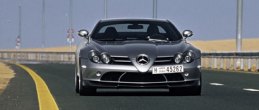 Sadly,
the 722 Edition did not correct the two major flaws of the original
car: the vague steering and the difficult-to-modulate Sensotronic
brakes. Oddly, Mercedes has already ditched the brake-by-wire
Sensotronic system from its mainstream cars, why didn't it do the same
to its top supercar ? because of tight development budget, I guess. It
only enlarged the carbon ceramic discs from 370mm to 390mm to increase
stopping power. Again, this answered a question nobody asked. Sadly,
the 722 Edition did not correct the two major flaws of the original
car: the vague steering and the difficult-to-modulate Sensotronic
brakes. Oddly, Mercedes has already ditched the brake-by-wire
Sensotronic system from its mainstream cars, why didn't it do the same
to its top supercar ? because of tight development budget, I guess. It
only enlarged the carbon ceramic discs from 370mm to 390mm to increase
stopping power. Again, this answered a question nobody asked.
Without providing the necessary human-machine communication, SLR 722
feels rather one-dimensional. Even with a slight performance boost, it
is no longer that sensational compare to 3 years ago. This special
edition is not the saviour the SLR needs. |
| The
above report was last updated on 11 Feb
2007. All Rights Reserved. |
SLR Roadster
|
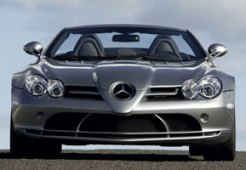 Mercedes-McLaren
originally planned to sell 3,500 SLRs in a production period of 7
years, but as the car is not as good as people expected, only 1,200
cars were sold during the first 3 and a half years, and the trend is
declining as the car is getting old. The addition of 722 edition did
not help much to stimulate interest. Now Mercedes is introducing
probably the last version of SLR – Roadster. It will replace the coupe
in the remaining years of production. Mercedes hopes that the open
version will be more appealing to wealthy customers as it has less
direct competitors, at least until Ferrari cut away the roof of 599 GTB. Mercedes-McLaren
originally planned to sell 3,500 SLRs in a production period of 7
years, but as the car is not as good as people expected, only 1,200
cars were sold during the first 3 and a half years, and the trend is
declining as the car is getting old. The addition of 722 edition did
not help much to stimulate interest. Now Mercedes is introducing
probably the last version of SLR – Roadster. It will replace the coupe
in the remaining years of production. Mercedes hopes that the open
version will be more appealing to wealthy customers as it has less
direct competitors, at least until Ferrari cut away the roof of 599 GTB.
The conversion from coupe to roadster is easier than conventional cars
because its carbon-fiber monocoque chassis is inherently strong and
needs only minor reinforcement around the windscreen and roll over bars
behind the seats. The loss of
torsional rigidity is minimal, so handling and ride show no discernible
differences. Weight is up by 57 kilograms, but considering the coupe
already weighed 1693 kg, it represents only an increase of 3 percent.
Engine is the same 626 hp supercharged 5.4-liter V8 as the coupe rather
than the 722's highly tuned version, surprisingly. However, the SLR
Roadster can still goes from zero to sixty in 3.7 seconds. Depending on
whether you believe, top speed is down by just 1 mph to 206 mph. The
fabric roof must be made of aerospace materials, or Mercedes-McLaren
must be over-optimistic.
The electric soft roof is by no means the most sophisticated
part of the SLR, because it is only semi-automatic. The driver will
need to unlatch it from the windscreen header rail and push it up, then
the electric actuators will fold it back. Open the roof actually helps
solving one of the old problems of SLR – the lack of headroom.
Nevertheless, the cabin is still tight for foot room and shoulder room.
We are still unconvinced by the contradicting character of the SLR, no
matter coupe or roadster. On the one hand its front-engined design, its
heavyweight and automatic gearbox suggest a luxury GT, on the other
hand its stiff ride, nervous steering and cramped cabin suggest an
uncompromising supercar. Comparatively, Ferrari 599 satisfies both
worlds a lot better. It is better to skip the SLR Roadster and wait for
599 Spider, Superamerica or the like. |
| The
above report was last updated on 31 Jul
2007. All Rights Reserved. |
SLR Stirling Moss
|
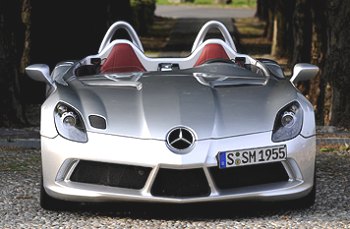
|
With neither roof nor windscreen, this
must be the wildest road car ever wearing a 3-pointed star badge...
|
Mercedes-Benz don’t
normally
name a car after a person. However, when that name is Stirling Moss, it
is another matter. Few ex-racing drivers in history were so closely
associated with a make like Stirling Moss with Mercedes. Half a century
has passed since his golden era, Moss still actively participates in
classic car events, comments on recent Formula One affairs with his
highly respectable tone and frank character. The British loves him,
unquestionably. The German also admire him, unexpectedly. He is
probably the only common hero to old generation British and German, and
that started before The Beatles landed on Hamburg.
In 1955, Stirling Moss drove Mercedes 300SLR to the famous victories in
Mille Miglia and Targa Florio. Unfortunately, later in that year
another Silver Arrow crashed in Le Mans and killed 82 spectators.
Mercedes withdrew from all kinds of motor racing for the next three
decades. That is why 300SLR is still remembered as the definitive race
car from Stuttgart.
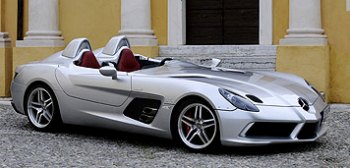
|
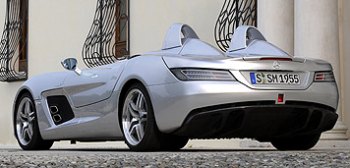 |
|
When
McLaren was
brainstorming to build the final edition of its SLR supercar, it wanted
to make something really special in both looks and performance.
Inspired by Stirling Moss’ race-winning 300SLR, Woking decided to adopt
a speedster architecture, with neither roof nor windscreen to reduce
drag and weight to the minimum. This must be the wildest road car ever
wearing a 3-pointed star badge. As it links to the greatest racing
history of Mercedes, no other name could be more appropriate than SLR
Stirling Moss.
The conversion from the standard SLR to Stirling Moss edition is not
just chopping off the roof and windscreen. In fact, all body panels,
head and tail lights have been redesigned to deliver a more aggressive
appearance. It also requires additional strengthening to the
carbon-fiber monocoque to compensate for the lost rigidity. Door sills
are raised considerably as a result, leading to a pair of miniature
doors to be adopted. They still swing forward and upward in butterfly
style, but now pivot on only one point. Behind the seats are additional
cross members and a pair of rollover protection bars. The cockpit is
also thoroughly redesigned to the extent that having no visual linkage
with the standard car. You have to jump over the high door sill to drop
into the bucket seat, a skill Stirling Moss used to handle so well.
Cutting the carbon-fiber roof alone may not save many kilograms, but
gone together with it are the heavier glass windscreen, rear window,
side windows and their power mechanism. Furthermore, no one needs
air-conditioning, audio system and sound insulation in an open car, so
they have been ditched as well. Altogether, the Stirling Moss weighs
140 kg less than the standard SLR, or 100 kg lighter than the 722
edition.

|
You have to jump over the high door
sill to drop into the bucket seat, a skill Stirling Moss used to handle
so well.
|
The 5.5-liter supercharged V8 in Stirling Moss edition is carried over
intact from 722, which had fully exploited its potential to 650
horsepower. However, propelling less weight means its 0-60 mph
acceleration can be reduced from 3.5 to merely 3.4 seconds. The much
reduced frontal area enables top speed to be raised from 209 mph to 217
mph, overtaking Pagani Zonda F, if not quite in the same league as
Bugatti Veyron and Koenigsegg CCXR.
Guiding the SLR Stirling Moss to that speed certainly needs a strong
courage - Stirling Moss should know that very well. Above 100 mph, the
wind deflectors can no longer contain the blast of wind, by then a
helmet will be a must. At lower speed maneuver, the car displays
slightly keener turn-in and less roll than other SLRs, thanks to the
lowered center of gravity. However, its handling and ride is still less
well accomplished than most other supercars. Stirling Moss or not, the
SLR is still primarily an Autobahn rocket.
McLaren will build 75 units of this goodbye edition, each priced at an
astonishing €750,000 or £660,000. After that, the SLR line will
be history. If your billion-dollar wealth has not been wiped out by the
credit crunch, and your childhood dream car was Stirling Moss' Silver
Arrow, you had better to consider this investment seriously.
|
| The
above report was last updated on 29 Jun
2009. All Rights Reserved. |
|
|